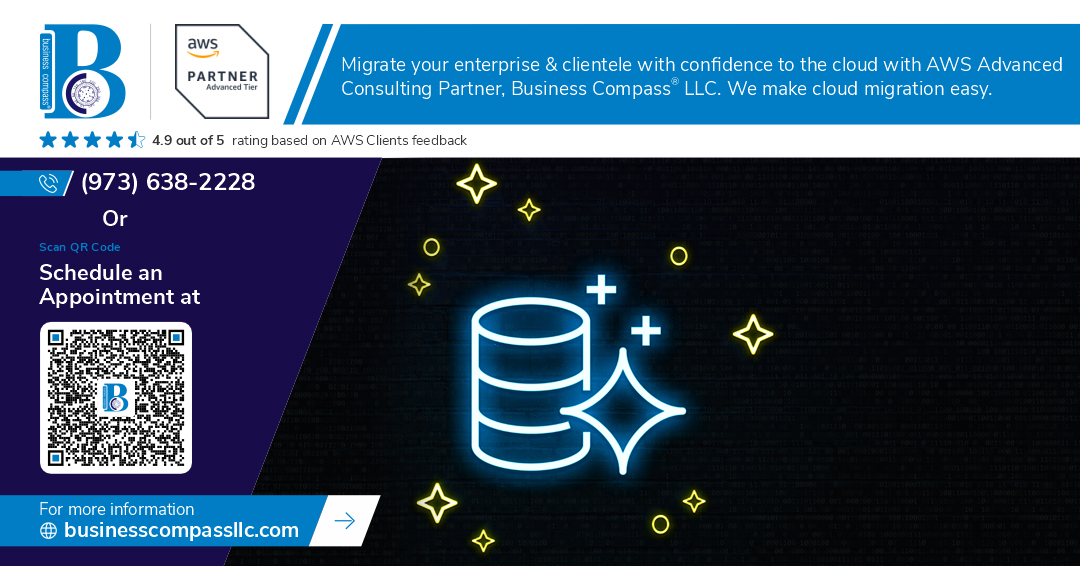🚀 Are you ready to unlock the power of cloud databases? In today’s data-driven world, choosing the right database solution can make or break your application’s performance. But with so many AWS database services available, where do you even begin?
Fear not! Whether you’re a budding developer or a seasoned IT professional looking to expand your skillset, this beginner’s guide will demystify AWS’s impressive array of database offerings. From the versatile Relational Database Service (RDS) to the lightning-fast DynamoDB, we’ll explore how each service can revolutionize your data management strategy.
In this comprehensive guide, we’ll dive into the world of AWS databases, covering everything from the high-performance Aurora engine to the scalable data warehousing solution, Redshift. We’ll also uncover the benefits of in-memory caching with ElastiCache and share best practices to help you maximize your AWS database experience. So, buckle up and get ready to transform your understanding of cloud databases – your journey to becoming an AWS database pro starts here! 💪💻
Understanding AWS Database Services
A. What are AWS database services?
AWS database services are cloud-based solutions provided by Amazon Web Services to help businesses store, manage, and analyze data efficiently. These services offer a wide range of database options, including relational, non-relational, and specialized databases, to cater to various application needs.
Here’s a quick overview of the main AWS database services:
| Service | Type | Key Features |
|---|---|---|
| RDS | Relational | Easy setup, scalability, automated backups |
| DynamoDB | NoSQL | Fully managed, serverless, low latency |
| Aurora | Relational | MySQL/PostgreSQL compatible, high performance |
| Redshift | Data Warehouse | Petabyte-scale, columnar storage |
| ElastiCache | In-Memory | Redis and Memcached support, real-time performance |
B. Benefits of using AWS for databases
Using AWS database services offers several advantages:
- Scalability: Easily scale your database resources up or down based on demand
- High availability: Built-in replication and automatic failover ensure continuous operation
- Security: Advanced security features like encryption at rest and in transit
- Cost-effective: Pay-as-you-go pricing model with no upfront costs
- Managed services: AWS handles maintenance, patching, and backups
C. Choosing the right database for your needs
Selecting the appropriate AWS database service depends on your specific requirements:
- Data structure: Choose relational databases (RDS, Aurora) for structured data, and NoSQL (DynamoDB) for flexible schemas
- Performance needs: Consider Aurora for high-performance relational databases or ElastiCache for real-time applications
- Scalability: DynamoDB offers seamless scaling for large-scale applications
- Analytics: Redshift is ideal for data warehousing and complex analytics
- Compatibility: RDS supports popular database engines like MySQL, PostgreSQL, and Oracle
Now that we’ve covered the basics of AWS database services, let’s dive deeper into the Relational Database Service (RDS) to understand its features and use cases.
Relational Database Service (RDS)
Overview and key features
Amazon Relational Database Service (RDS) is a managed database service that simplifies the setup, operation, and scaling of relational databases in the cloud. Key features include:
- Automated patching and backups
- High availability with Multi-AZ deployments
- Read replicas for improved performance
- Scalability with vertical and horizontal scaling options
- Encryption at rest and in transit
| Feature | Description |
|---|---|
| Automated Management | Handles routine database tasks |
| High Availability | Multi-AZ deployments for failover |
| Performance | Read replicas and optimized storage |
| Security | Encryption and network isolation |
Supported database engines
RDS supports multiple database engines, catering to various application needs:
- MySQL
- PostgreSQL
- MariaDB
- Oracle
- Microsoft SQL Server
Use cases and benefits
RDS is ideal for:
- Web and mobile applications
- E-commerce platforms
- Content management systems
- Enterprise resource planning (ERP) software
Benefits include:
- Reduced administrative overhead
- Improved scalability and performance
- Enhanced security and compliance
- Cost-effective database management
Getting started with RDS
To begin using RDS:
- Choose a database engine
- Select an instance type
- Configure storage and network settings
- Set up security groups and access controls
- Launch the RDS instance
RDS simplifies database management, allowing developers to focus on application development rather than infrastructure maintenance. With its wide range of supported engines and powerful features, RDS is a versatile solution for various database needs in the cloud.
DynamoDB: NoSQL Database Solution
What is DynamoDB?
DynamoDB is a fully managed NoSQL database service provided by Amazon Web Services (AWS). It offers seamless scalability, high performance, and automatic multi-region replication. Unlike traditional relational databases, DynamoDB uses a key-value and document data model, making it ideal for applications that require low-latency data access at any scale.
Key features and advantages
DynamoDB offers several key features that make it a popular choice for modern applications:
- Scalability: Automatically scales to handle massive amounts of data and traffic
- Performance: Single-digit millisecond latency at any scale
- Fully managed: No need to manage servers or infrastructure
- Flexible data model: Supports both key-value and document data structures
- Multi-region replication: Ensures high availability and disaster recovery
| Feature | Advantage |
|---|---|
| Serverless | Pay only for what you use |
| On-demand capacity | Automatically adapts to workload changes |
| ACID transactions | Ensures data integrity across multiple items |
| Time-to-live (TTL) | Automatically deletes expired items |
Use cases for DynamoDB
DynamoDB is well-suited for various applications, including:
- Mobile and web applications
- Gaming leaderboards and user profiles
- IoT device data storage
- Session management for web applications
- Real-time bidding platforms
- Fraud detection systems
Setting up your first DynamoDB table
To create your first DynamoDB table:
- Sign in to the AWS Management Console
- Navigate to the DynamoDB service
- Click “Create table”
- Enter a table name and primary key
- Choose provisioned or on-demand capacity
- Configure additional settings (if needed)
- Review and create the table
Now that we’ve covered DynamoDB, let’s explore Aurora, AWS’s high-performance database engine.
Aurora: High-Performance Database Engine
Introduction to Aurora
Amazon Aurora is a powerful, fully managed relational database engine that combines the speed and reliability of high-end commercial databases with the simplicity and cost-effectiveness of open-source databases. As part of the AWS ecosystem, Aurora offers seamless integration with other AWS services, making it an attractive choice for businesses of all sizes.
Compatibility with MySQL and PostgreSQL
Aurora’s compatibility with MySQL and PostgreSQL enables easy migration and familiar development processes:
| Feature | MySQL Compatibility | PostgreSQL Compatibility |
|---|---|---|
| Version | 5.6, 5.7, 8.0 | 9.6, 10, 11, 12, 13 |
| Syntax | Fully compatible | Fully compatible |
| Tools | Works with existing MySQL tools | Works with existing PostgreSQL tools |
| Migration | Simple migration using AWS Database Migration Service | Straightforward migration using native PostgreSQL tools |
Performance benefits
Aurora offers significant performance improvements over traditional databases:
- Up to 5x throughput of standard MySQL
- Up to 3x throughput of standard PostgreSQL
- Auto-scaling storage up to 128 TB
- Low-latency read replicas for improved read performance
- Distributed storage architecture for enhanced durability
When to choose Aurora
Consider Aurora for your database needs when:
- You require high performance and scalability
- Your application demands high availability and disaster recovery
- You want to reduce database management overhead
- You need compatibility with MySQL or PostgreSQL
- Cost-effectiveness is a priority for your database solution
Aurora’s combination of performance, compatibility, and managed services makes it an excellent choice for a wide range of applications, from small startups to large enterprises requiring robust database solutions.
Redshift: Data Warehousing Solution
Understanding data warehousing
Data warehousing is a crucial component of modern business intelligence and analytics. It involves collecting, storing, and managing large volumes of data from various sources to support decision-making processes. Here’s a breakdown of key aspects:
- Definition: A centralized repository for storing and analyzing historical data
- Purpose: Enable data-driven decision making and business intelligence
- Data types: Structured, semi-structured, and unstructured data
| Characteristic | Operational Database | Data Warehouse |
|---|---|---|
| Data focus | Current transactions | Historical data |
| Query type | Simple, frequent | Complex, analytical |
| Performance | Fast for transactions | Optimized for analysis |
| Data model | Normalized | Denormalized |
Redshift architecture and features
Amazon Redshift is AWS’s fully managed data warehousing solution, designed for high-performance analysis of large datasets. Key features include:
- Columnar storage
- Massively Parallel Processing (MPP)
- Advanced compression
- Scalability up to petabytes of data
Use cases for Redshift
Redshift excels in various scenarios:
- Business intelligence and reporting
- Big data analytics
- Log analysis
- Real-time analytics for e-commerce
Setting up a Redshift cluster
To get started with Redshift:
- Log into AWS Management Console
- Navigate to the Redshift service
- Click “Create cluster”
- Configure cluster details (node type, number of nodes)
- Set up network and security options
- Review and launch the cluster
Now that we’ve covered Redshift’s capabilities for data warehousing, let’s explore ElastiCache, AWS’s solution for in-memory caching to further enhance your database performance.
ElastiCache: In-Memory Caching
What is ElastiCache?
ElastiCache is Amazon’s fully managed in-memory caching service designed to improve application performance by reducing database load. It supports two popular open-source engines: Redis and Memcached. By storing frequently accessed data in memory, ElastiCache significantly reduces latency and enhances overall system responsiveness.
Supported engines: Redis and Memcached
| Feature | Redis | Memcached |
|---|---|---|
| Data structures | Complex (strings, lists, sets, hashes) | Simple (key-value pairs) |
| Persistence | Supported | Not supported |
| Replication | Multi-AZ with automatic failover | Not supported |
| Pub/Sub messaging | Supported | Not supported |
| Scaling | Vertical and horizontal | Horizontal only |
Improving application performance with caching
Implementing ElastiCache can dramatically enhance your application’s performance:
- Reduced database load
- Faster response times
- Increased throughput
- Better scalability
- Improved user experience
Implementing ElastiCache in your project
To integrate ElastiCache into your application:
- Choose the appropriate engine (Redis or Memcached)
- Create an ElastiCache cluster in your desired AWS region
- Configure security groups and network settings
- Update your application code to interact with the cache
- Implement cache invalidation strategies to ensure data consistency
By leveraging ElastiCache, you can significantly improve your application’s performance and scalability. Next, we’ll explore best practices for managing AWS database services to ensure optimal performance and security.
Best Practices for AWS Database Management
A. Security considerations
When managing AWS databases, security should be your top priority. Implement the following best practices:
- Use VPCs and security groups to control network access
- Enable encryption at rest and in transit
- Implement strong IAM policies and rotate credentials regularly
- Enable AWS CloudTrail for auditing database activities
| Security Feature | Description |
|---|---|
| VPC | Isolates database instances in a private network |
| Encryption | Protects data from unauthorized access |
| IAM Policies | Controls user access and permissions |
| CloudTrail | Logs API calls for security analysis |
B. Monitoring and optimization
Effective monitoring ensures optimal database performance:
- Set up Amazon CloudWatch alarms for key metrics
- Use AWS Performance Insights for deep performance analysis
- Regularly review and optimize database queries
- Implement automated scaling based on performance metrics
C. Backup and disaster recovery
Protect your data with robust backup and recovery strategies:
- Configure automated backups with appropriate retention periods
- Test your disaster recovery plan regularly
- Use cross-region replication for critical databases
- Implement point-in-time recovery for granular data restoration
D. Scaling strategies
Ensure your databases can handle growth:
- Use read replicas to distribute read traffic
- Implement sharding for horizontal scaling in DynamoDB
- Leverage Aurora’s auto-scaling capabilities
- Consider caching with ElastiCache to reduce database load
E. Cost optimization tips
Optimize your database costs without compromising performance:
- Right-size your database instances based on actual usage
- Use Reserved Instances for predictable workloads
- Implement lifecycle policies to manage data storage costs
- Regularly review and delete unused resources
By following these best practices, you’ll ensure your AWS databases are secure, performant, and cost-effective. Next, we’ll explore how to choose the right AWS database service for your specific needs.
AWS offers a diverse range of database services to cater to various application needs. From the versatile Relational Database Service (RDS) to the high-performance Aurora, the scalable NoSQL solution DynamoDB, the data warehousing powerhouse Redshift, and the lightning-fast caching of ElastiCache, each service brings unique strengths to the table. By understanding these services and implementing best practices for database management, you can optimize your data storage and retrieval operations in the cloud.
As you embark on your journey with AWS database services, remember that choosing the right solution depends on your specific use case, scalability requirements, and performance needs. Start small, experiment with different services, and gradually build your expertise. With AWS’s robust database offerings, you’re well-equipped to create efficient, scalable, and powerful data-driven applications in the cloud.




















